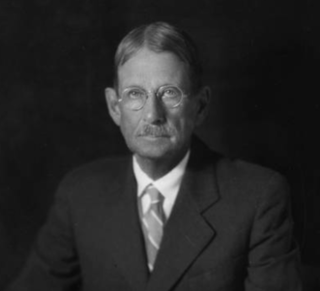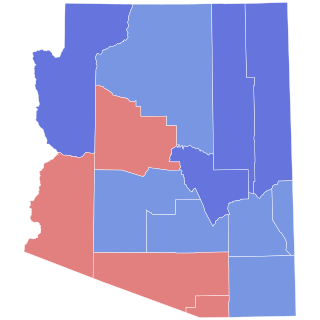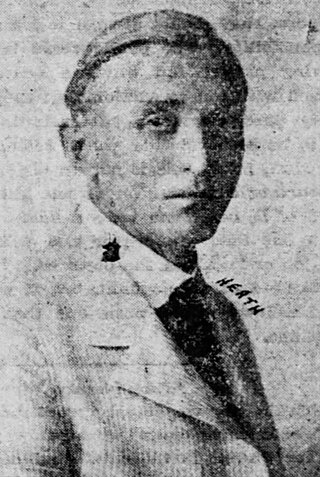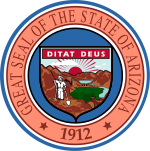
Rawghlie Clement Stanford was an American judge and politician who served as the fifth governor of Arizona from 1937 to 1939. He later served on the Arizona Supreme Court from 1943 until 1955, including three years as chief justice.

The Arizona Democratic Party is the affiliate of the Democratic Party in the U.S. state of Arizona. Its headquarters are in Phoenix.

Adam Dorsey Driggs is an American attorney, politician, and as of 2017, a judge of the Maricopa County Superior Court in Arizona. Driggs previously served in both chambers of the Arizona State Legislature.

The 1920 United States Senate election in Arizona took place on November 2, 1920. Incumbent Democratic U.S. Senator Marcus A. Smith ran for reelection to a third term, but was defeated by former Delegate to the U.S. House of Representatives from the Arizona Territory Ralph H. Cameron in the general election. Cameron would become the first Republican elected to the office of U.S. Senator from Arizona since the state joined the union in 1912. The same year, Republican Governor Thomas Edward Campbell was reelected to a second term.

The 1982 Arizona gubernatorial election took place on November 2, 1982, for the post of Governor of Arizona. Democratic incumbent Bruce Babbitt defeated Republican nominee Leo Corbet and Libertarian candidate and former U.S. Representative Sam Steiger. Evan Mecham unsuccessfully ran for the Republican nomination. This was the last time until 2002 that a Democrat was elected governor of Arizona, and the last time a male Democrat was elected governor.

Kimberly Yee is an American politician serving as the 45th Arizona state treasurer. She is the first Asian-American woman elected to the Arizona State Legislature.

The 1916 Arizona gubernatorial election took place on November 7, 1916, for the post of the Governor of Arizona. Due to battles between labor and business, the Hunt administration was facing severe electoral backlash. After facing a fairly strong primary by former Council member George Olney, Hunt prevailed and went on to face the closest election in Arizona gubernatorial history. The initial results of the 1916 election were extremely close, with Campbell winning by only 30 votes.

The 1918 Arizona gubernatorial election took place on November 5, 1918, for the post of the Governor of Arizona. Thomas Campbell, who served a partial term in 1917 and had his election overturned by the Supreme Court of Arizona, returned to contest the Governors office. Incumbent Governor Hunt declined to run again after the stress of the close elections and the year-long court battle. Despite falling to its lowest percentage in years, the sole third party challenger held the difference between the two candidates. The Democratic challenger was state senator Fred T. Colter, a pro-Hunt Democrat.

The 1926 Arizona gubernatorial election took place on November 2, 1926. Despite being a Democratic year generally, Hunt barely managed to be re-elected against his Republican opponent Elias Clark. Hunt had been governor for around 11 out of the State of Arizona's 14 years, coupled with his age and with issues regarding the Colorado River Compact, he was running out of steam. Despite that Hunt narrowly prevailed and won.

The 1928 Arizona gubernatorial election took place on November 6, 1928. Despite a fairly poor economy, a 15-point loss by Al Smith for the Arizona electoral votes, and having served for nearly 6 full terms, Hunt only narrowly lost the general election. Other state Democrats like Senator Ashurst and Representative Douglas both won re-election. John C. Phillips became the second Republican to serve as Arizona Governor, and the first to beat Hunt in a general election.

Frank Hubbard Lyman was a justice of the Supreme Court of Arizona from January 1, 1923, to January 5, 1925.

Renz L. Jennings was a justice of the Supreme Court of Arizona from December 12, 1960 to August 5, 1964. Jennings twice sought the Democratic nomination for the United States Senate, losing in 1934 and 1964.

The 1930 Arizona gubernatorial election took place on November 4, 1930. George W. P. Hunt narrowly won the general election in 1930, defeating incumbent governor John Calhoun Phillips, who had defeated Hunt in his bid for reelection in the previous election year in 1928.

The 1932 Arizona gubernatorial election took place on November 8, 1932. Incumbent Governor George W. P. Hunt ran for the Democratic nomination, but lost in the primary to Benjamin Baker Moeur, whose pre-gubernatorial experience included service as the Secretary of the Board of Education for Arizona State Teacher's College, which would later become Arizona State University.

The 1936 Arizona gubernatorial election took place on November 3, 1936. Incumbent Governor Benjamin Baker Moeur ran for reelection, but he was defeated in the Democratic primary by former judge of the Maricopa County Superior Court Rawghlie Clement Stanford.

The 1938 Arizona gubernatorial election took place on November 8, 1938. Incumbent Governor Rawghlie Clement Stanford declined to run for reelection, with pharmacy and cattle ranch owner Robert Taylor Jones winning the Democratic nomination to succeed Stanford.

The 1956 Arizona gubernatorial election took place on November 6, 1956. Incumbent Governor Ernest McFarland ran for reelection to a second term. Ernest McFarland defeated longtime The Arizona Republic journalist and Republican nominee Horace B. Griffen in the general election by a wide margin.

The 2022 Arizona Superintendent of Public Instruction election took place on November 8, 2022, to elect the Superintendent of Public Instruction of Arizona. Incumbent Democratic Superintendent Kathy Hoffman was defeated in her run for a second term by former Republican Attorney General Tom Horne. Significantly, Horne's win marked the first time in the state's history that a Republican won a statewide race without winning Maricopa County, home to 62% of the state's population and a former Republican stronghold; the only other statewide 2022 Republican candidate to win that year, Kimberly Yee, won her race by a wide margin partly by carrying Maricopa County.

H. A. Davis (1879-1946) was an American politician from Arizona, who served as a senator in the 1st Arizona State Legislature. He was also a newspaperman and owned a printing business.

Joe C. Haldiman was an American politician from Arizona. He served three terms in the Arizona State Senate during the 10th, 12th, and 15th Arizona State Legislatures, holding one of the two seats from Maricopa County.























